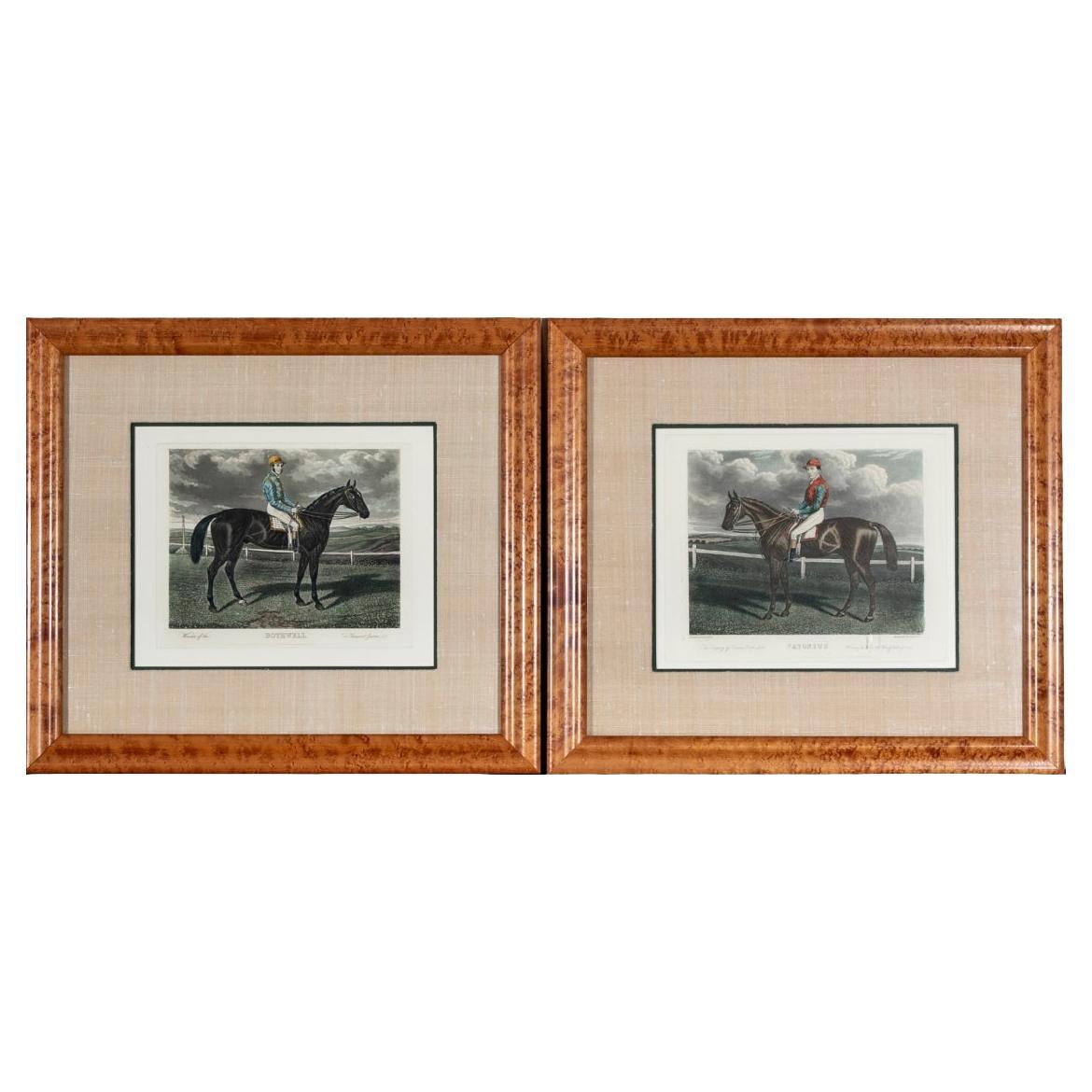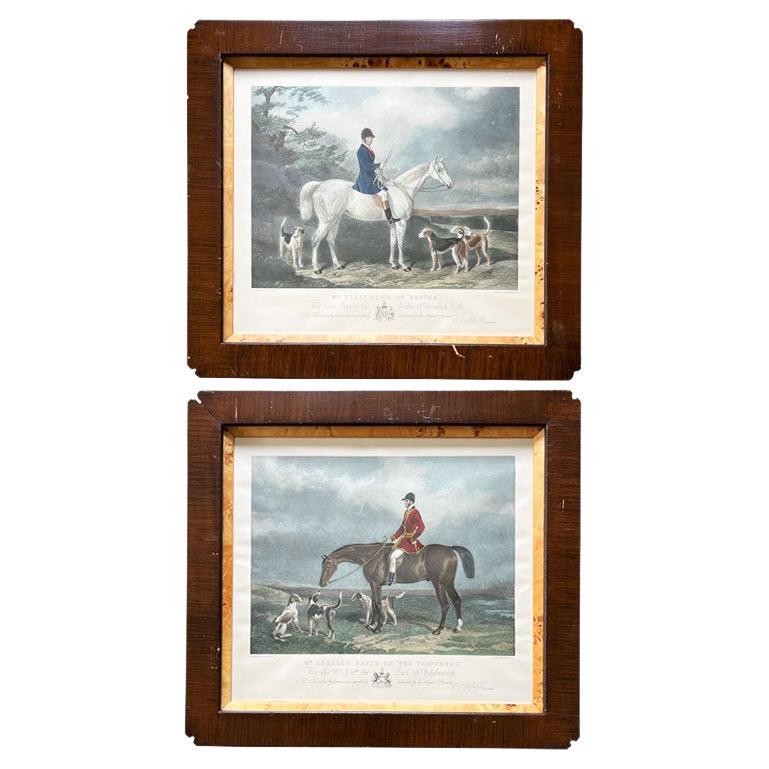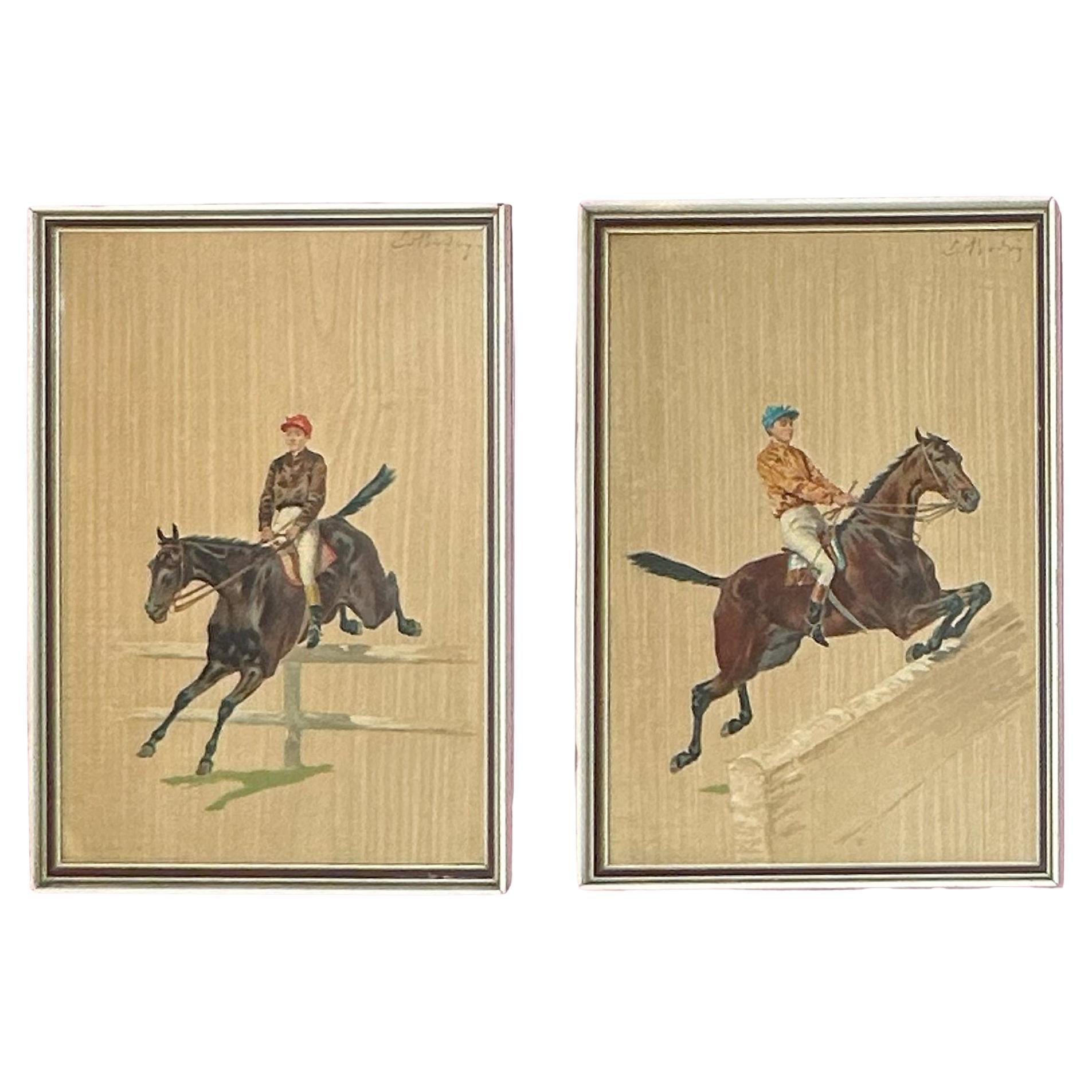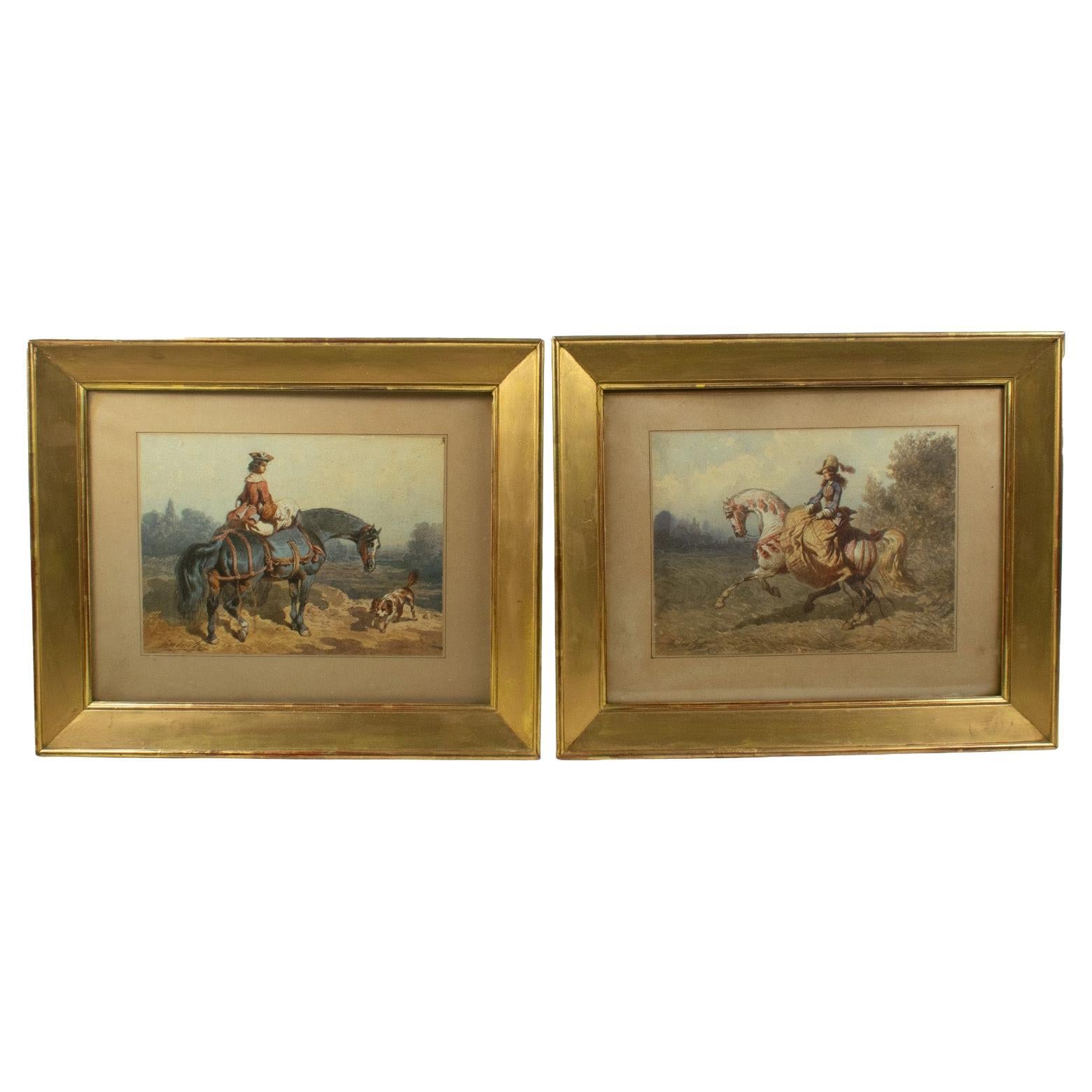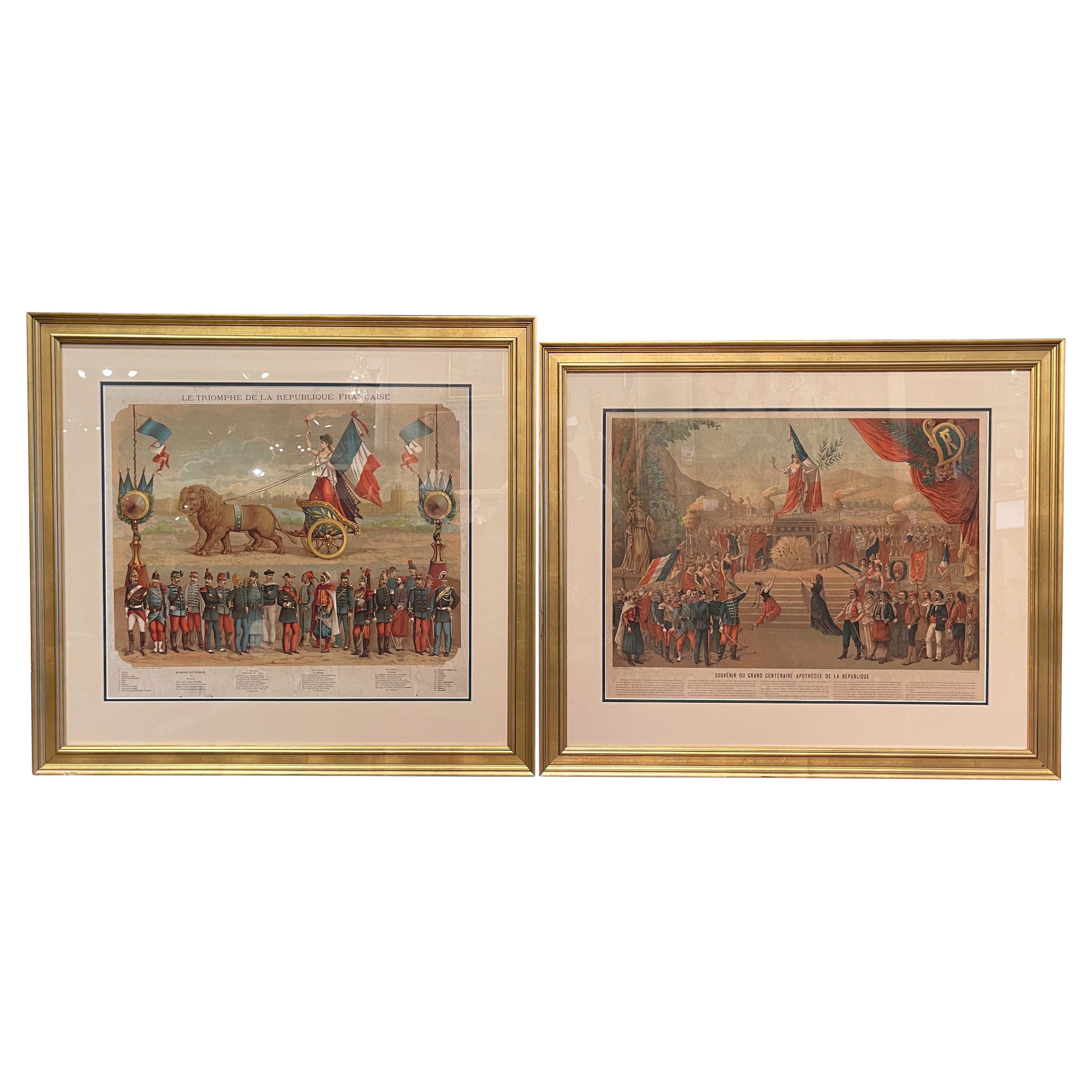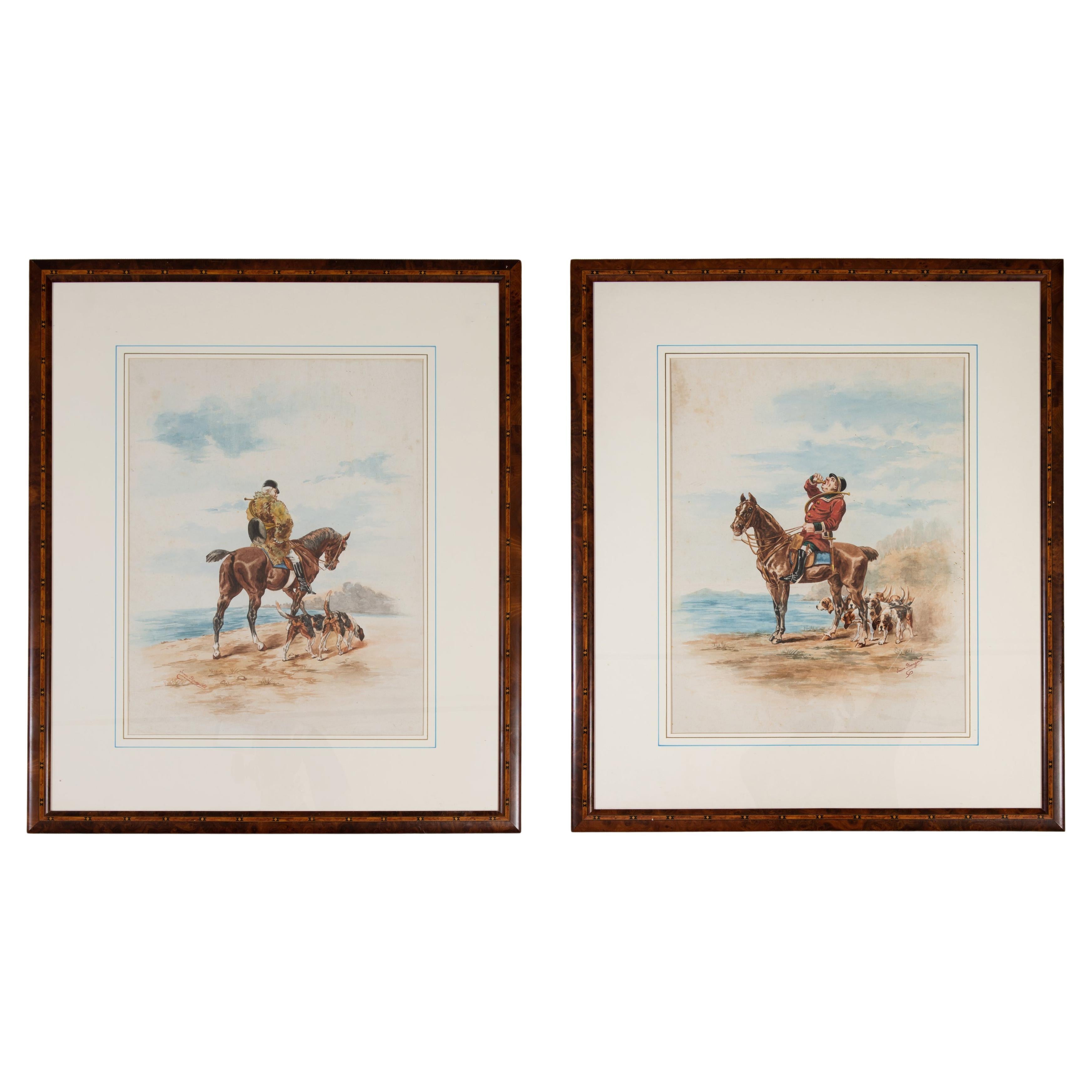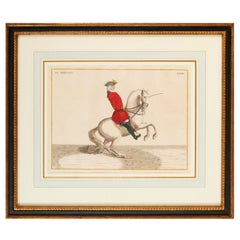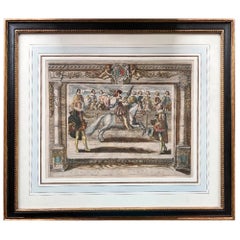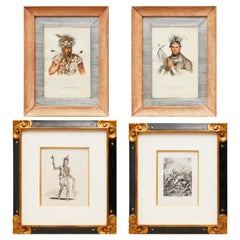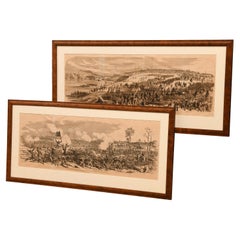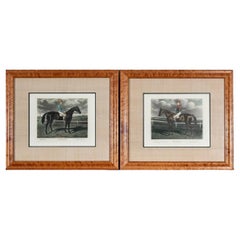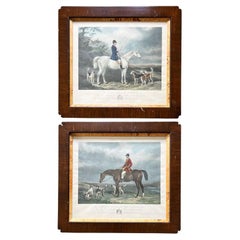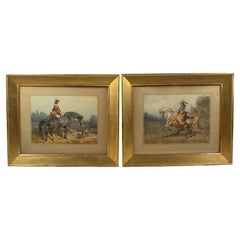Items Similar to 1930's France, Pair of Signed Eugène Pechaubès Hand-Colored Cavalry Prints
Want more images or videos?
Request additional images or videos from the seller
1 of 13
1930's France, Pair of Signed Eugène Pechaubès Hand-Colored Cavalry Prints
$1,995per set
£1,500.72per set
€1,738.51per set
CA$2,812.54per set
A$3,127.73per set
CHF 1,641.34per set
MX$38,141.15per set
NOK 20,747.07per set
SEK 19,451.20per set
DKK 12,976.05per set
About the Item
Artist: Eugène Pechaubès (French, 1890–1967)
Titles: India – Body Guards – Officer and 1er Empire Garde Impériale – Trompette du 2e Lanciers
Medium: Offset lithographs or gravure with hand-coloring
Signature: Pencil signed lower right on both works
Country: France
Date: Mid-20th century
Description:
A striking pair of hand-colored equestrian military prints by French artist Eugène Pechaubès, best known for his detailed depictions of historic cavalry regiments and Napoleonic pageantry. Each image is richly rendered and delicately enhanced with watercolor by hand, highlighting the ornate uniforms and regalia of elite mounted units.
The first work depicts an officer of the Indian Body Guards, dramatically posed on a powerful bay steed in full scarlet regimental dress. The second features a trumpeter of the 2nd Lancers of Napoleon's Imperial Guard, resplendent on a white horse with red and gold livery, set against a light wash of ground and sky.
These works reflect Pechaubès’s passion for historical costume and military ceremony, combining documentary accuracy with painterly flair. The artist exhibited at the Salon des Artistes Français and was known for capturing the grandeur of mounted troops with elegance and precision.
Both prints are pencil signed in the margin and beautifully matted and framed, ready to hang. A handsome and highly collectible set for the militaria enthusiast, equestrian art collector, or traditional interior.
One print is titled "1er Empire Garde Impériale Trompette du 2e Lanciers", referring to the Napoleonic Imperial Guard, a favorite theme in Pechaubès's oeuvre.
The other, "India – Body Guards – Officer", suggests Pechaubès also turned to depicting colonial and ceremonial military uniforms of other empires—especially during a time when European interest in colonial subjects and historic pageantry was high (1930s–40s).
Dimensions:
Sight Dimensions (each): 9.25 in. H x 7.75 in. W
Framed Dimensions (each): 14.75 in. H x 13 in. W
Condition:
Good, no visible issues; not examined out of frames. Presented under glass in period gilt frames with cream matting.
- Creator:Eugene Pechaubes (Artist)
- Dimensions:Height: 14.75 in (37.47 cm)Width: 13 in (33.02 cm)Depth: 0.5 in (1.27 cm)
- Sold As:Set of 2
- Style:Empire Revival (In the Style Of)
- Materials and Techniques:
- Place of Origin:
- Period:
- Date of Manufacture:1930's
- Condition:Wear consistent with age and use.
- Seller Location:Morristown, NJ
- Reference Number:1stDibs: LU5990245013672
Eugene Pechaubes
Eugène Pechaubès was French painter and printmaker best known for his depictions of racehorses. He first became known for military scenes, particularly related to the Second Empire. Later he turned almost exclusively to action scenes of horses at celebrated French race courses.
About the Seller
5.0
Platinum Seller
Premium sellers with a 4.7+ rating and 24-hour response times
Established in 2020
1stDibs seller since 2021
219 sales on 1stDibs
Typical response time: <1 hour
- ShippingRetrieving quote...Shipping from: Morristown, NJ
- Return Policy
Authenticity Guarantee
In the unlikely event there’s an issue with an item’s authenticity, contact us within 1 year for a full refund. DetailsMoney-Back Guarantee
If your item is not as described, is damaged in transit, or does not arrive, contact us within 7 days for a full refund. Details24-Hour Cancellation
You have a 24-hour grace period in which to reconsider your purchase, with no questions asked.Vetted Professional Sellers
Our world-class sellers must adhere to strict standards for service and quality, maintaining the integrity of our listings.Price-Match Guarantee
If you find that a seller listed the same item for a lower price elsewhere, we’ll match it.Trusted Global Delivery
Our best-in-class carrier network provides specialized shipping options worldwide, including custom delivery.More From This Seller
View AllBaron Rais d'Eisenberg, Hand-Colored Equestrian Engraving c. 1747, "Le Brillant"
By Eisenberg
Located in Morristown, NJ
18th century German, a hand-colored engraving of a dressage horse and rider from Description du Manège Moderne by Friedrich Wilhelm, Baron Rais d' Eisenberg (German, ca. 1700-ca. 1770). Engraved by Bernard Picart (French, 1673-1733). Titled "Le Brillant", this dressage engraving is plate XXXIII. There is a gallery label verso. The print is matted and framed under UF-3 plexiglass, which offers the maximum amount of UV protection (approx. 97%).
This print was originally part of an illustrated book Baron d'Eisenberg made describing the art of the cavaliers and depicting the different breeds of horses- The full title of the book is L'Art de Monter a Cheval: ou Description du Manége Moderne, Dans sa Perfection, published in Leipzig: Arkstée et Merkus, 1747). A set of 7 framed engravings from the same book sold at Sotheby's for $9,500 (plus tax and buyers premium).
Reference:
The author, a German horseman and artist, spent some of his youth at the manège of Saxe-Weimar before entering into the service of the Emperor. He then spent six years in Naples as the Master of Horse of the Viceroy before returning to Vienna where he studied under M. de Regenthal, the imperial Master of Horse. He participated in the coronation of the Emperor Charles V at Frankfurt in 1711, then spent some time in England, but was back in Germany before 1753. He probably died in Tuscany where he was Director and Master of the Horse at the Academy in Pisa. Brunet II, 957; Mennessier de la Lance I, p. 438.
The Baron wrote several important and lavishly illustrated books on horses: his Description du manège moderne dans sa perfection, London 1727, and Dictionnaire des termes du manège moderne, 1747, being the best well-known.
He dedicated Description du Manège Moderne to King George II and to his son, His Royal Highness the Prince of Wales. Subscribers to the book included royalty and nobility from all over Europe.
The engraver was Bernard Picart, born in Paris in 1673. He gained honors at the Academy of Paris at the age of sixteen. He was a master designer and engraver and worked in Paris and Amsterdam until his death in 1733.
Dimensions:
9"h x 12"w (sight), 16.5"h x 19.25"w (frame)
Condition:
Good, some rippling to sheet, not examined out of frame.
Provenance:
Lombard Antiquarian Maps & Prints, Cape Elizabeth...
Category
Antique 1740s German Rococo Drawings
Materials
Plexiglass, Wood, Paint, Paper
C. 1625 After Antoine de Pluvinel, "Henry IV, Mounted", Hand Colored Engraving
Located in Morristown, NJ
Early 17th century, French hand colored equestrian engraving. After Antoine de Pluvinel (French, 1552-1620), "Henry IV, Mounted", figure 42 from "L'Instruction du Roy en l'Exercice de Monter a Cheval", c. 1625, matted and framed under UF-3 plexiglass (blocks approx. 97% of UV) , gallery label verso. Figures from this publication have sold at Christie's. Those were not hand colored.
A highly detailed engraving with the French King Henry 1V the central figure. Mounted on horseback, Le Roy (the King) is watched by no less than 10 courtiers some of whom are mounted on horseback, all of which are named in the engraving.
Antoine de Pluvinel (1552, Crest, Dauphine - 24 August 1620) was the first of the French riding masters, and has had great influence on modern dressage. He wrote L’Instruction du Roy en L'exercice de Monter à Cheval ("instruction of the King in the art of riding"), was tutor to King Louis XIII, and is credited with the invention of using two pillars, as well as using shoulder-in to increase suppleness.
In 1594, Pluvinel founded the "Academie d'Equitation" near what is now Place des Pyramides. There, the French nobility was trained not only in horsemanship, but also in all the accomplishments (dancing, fashionable dressing, etc.) It can be said that Pluvinel's influence on the aristocracy lasted from the late 16th century to the 17th century. Richelieu, the future Prime Minister of King Louis XIII attended the Academie; so did William, Duke of Cavendish.
Pluvinel's book was published posthumously by the Flemish engraver Crispijn van de Passe II and the royal valet de chambre...
Category
Antique Early 17th Century French Baroque Prints
Materials
Plexiglass, Boxwood, Paint, Paper
19th C. American & European Lithos & Engravings Feat. Native Americans Subjects
By McKenney & Hall
Located in Morristown, NJ
Collection of 19th Century American and European Lithographs & Engravings Featuring Native American Subjects
A compelling group of four framed 19th-century prints, including two fin...
Category
Antique Mid-19th Century American American Colonial Prints
Materials
Glass, Wood, Paper
Pair of Framed Civil War Engravings - Frank Leslie's Illustrated Newspaper, 1862
Located in Morristown, NJ
Two framed prints are 19th-century engravings from Frank Leslie's Illustrated Newspaper, a significant publication during the Civil War era that visually documented important events ...
Category
Antique 1860s American American Classical Prints
Materials
Glass, Wood, Paper
19th C., Vanity Fair Framed Chromolithograph of Gentlemen Ex. Christie's
By Sir Leslie Ward
Located in Morristown, NJ
[English Gentlemen], from Vanity Fair chromolithograph, on wove papers. Printed by Vincent Brooks Day & Son., with various dates from 1875 to 1897.
Professionally framed with black and gilt frames and beige silk mats, with margins, apparently in excellent condition, not examined out of the frames.
Vanity Fair was a weekly magazine published in London, founded & edited by Thomas Gibson Bowles. His aim was to expose to contemporary vanities of Victorian society. From 1868 to 1914, full page colour lithographs appeared in most weekly issues, frequently lampooning or lauding their subjects which included artists, athletes, royalty, politicians, scientists, authors, actors, sportsmen, lawyers, diplomats, soldiers, clergy, scholars and other celebrities of the day - mostly British, but also many other internationally significant personalities. Over 2,300 of these colour cartoons were printed, and they are considered the chief cultural legacy of the magazine, forming a pictorial record of many of the most significant public figures of the period. They are renowned throughout the world and highly collectible and recognisable. Famous artists contributed to Vanity Fair, typically under pen names. The best remembered today is Leslie Ward (1851-1922), who signed his works as "Spy", and whose caricatures account for well over half of those featured in Vanity Fair. So famous have these fabulous prints become, Vanity Fair caricatures today often are referred to simply as "Spy Cartoons...
Category
Antique Late 19th Century English Late Victorian Prints
Materials
Glass, Wood, Paper
Prideaux John Selby and Robert Mitford, 4 Hand Colored Restrike Prints of Birds
By John Selby
Located in Morristown, NJ
From Selby's Illustrations of British Ornithology (London: 1841-1846). Likely a restrike printing (20th c.,) hand-colored prints, embossed with plate marks, includes two after Pridea...
Category
Early 20th Century English George IV Prints
Materials
Glass, Wood, Paint, Paper
You May Also Like
Two Antique Hand Colored English Equestrian Engravings
Located in Bridgeport, CT
One hand colored engraving depicting Bothwell ridden by jockey John Osborne Jr. winner of the Two Thousand Guineas Stakes in 1871. Published London, May 20th, 1871 by J. McQueen, 37 ...
Category
Antique 19th Century English Hollywood Regency Prints
Materials
Glass, Wood, Paper
19th-Century Pair of Equestrian Engravings – Framed Antique Hunting Prints
By William Barraud
Located in Oklahoma City, OK
Bring the allure of the English countryside into your home with this remarkable pair of antique equestrian prints. These hand-colored engravi...
Category
Antique 19th Century English Neoclassical Prints
Materials
Wood, Paper, Glass
Late 19th-Century French Equestrian Prints by Ernest Alexandre Bodoy, A. Legras
By Auguste Legras
Located in Glasgow, GB
Late 19th-Century French Equestrian chromolithograph prints by Ernest Alexandre Bodoy, A. Legras.
Capturing the exhilarating energy of equestrian steeplechase scenes, as originally...
Category
Antique 1880s French Napoleon III Prints
Materials
Wood, Lacquer, Paper
$442 Sale Price
20% Off
Théodore Fort (1810–1896) - Pair of Watercolours - Elegant Ladies on Horseback
Located in TEYJAT, FR
Théodore Fort (French, 1810–1896)
Femmes à cheval pendant leur chasse à courre — Pair of Watercolours - Ladies on horseback during a hunt.
Each signed lower left
Image size: 18 × 23 ...
Category
Antique Mid-19th Century French Paintings
Materials
Paper
Set of Two Early 20th Century French Revolution Prints in Custom Frames
Located in Dallas, TX
Decorate a game room, a den or an office with these two large framed antique prints. Printed in France circa 1900, each colorful artwork is set in a carved gilt wood frame and protected with glass; each depicts the souvenir and triumph of the "Revolution Francaise...
Category
Early 20th Century French Prints
Materials
Giltwood, Paper
Watercolors of Knights Hunting
Located in Alessandria, Piemonte
Pair of French watercolors of knights hunting during a break.
A moment of peace and nature: naturally painted by a woman..
Signed Jeanne Bourgailh -
I chose a thin but precious frame...
Category
Antique Late 19th Century French Other Drawings
Materials
Paper
$2,149 / set
